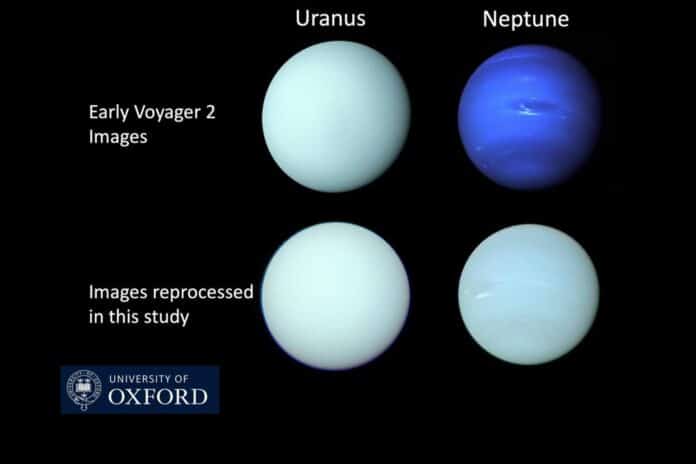Uranus and Neptune are far away planets in our Solar System, and they’re called ‘Ice Giants.’ They are tough to study because they are so distant. When we look at them without telescopes, they seem blue-green. This color comes from methane gas in their atmosphere, which absorbs green and red light.
People usually consider Neptune a deep blue planet and Uranus a light green one. However, a recent study led by Professor Patrick Irwin and his team from the University of Oxford discovered that both planets are more similar in color than we thought. They’re both a shade of greenish-blue.
We thought Neptune is deep blue and Uranus is light green because pictures taken during the 20th century, including those from NASA‘s Voyager 2 mission, were captured in different colors. These single-color images were then combined to make full-color pictures.
However, the blending was not always accurate to show the real colors, and in Neptune’s case, they made it look “too blue.” Moreover, the early images of Neptune from Voyager 2 were enhanced to highlight details like clouds and winds, which influenced our view of Neptune’s color.
Professor Patrick Irwin from the University of Oxford‘s Department of Physics said, “Although the familiar Voyager 2 images of Uranus were published in a form closer to “true” color, those of Neptune was, in fact, stretched and enhanced, and therefore made artificially too blue.”
“Even though the artificially saturated color was known at the time amongst planetary scientists – and the images were released with captions explaining it – that distinction had become lost over time. Applying our model to the original data, we have been able to reconstitute the most accurate representation of Neptune and Uranus’s color.”
For this new study, scientists used data from Hubble Space Telescope’s Space Telescope Imaging Spectrograph (STIS) and the Multi Unit Spectroscopic Explorer (MUSE) on the European Southern Observatory’s Very Large Telescope. Using data, scientists re-balanced the composite color images recorded by the Voyager 2 camera and also by the Hubble Space Telescope’s Wide Field Camera 3 (WFC3).
The study found that Uranus and Neptune are the same greenish-blue color. The small difference is that Neptune has a bit more blue; the study suggests this is because Neptune has a thinner layer of haze. This research also helps solve why Uranus changes its color slightly during its 84-year trip around the Sun.
To figure this out, scientists compared images of Uranus with brightness measurements taken by the Lowell Observatory in Arizona from 1950 to 2016. These measurements were done in blue and green wavelengths. They found that Uranus looks a bit more green during its solstices (summer and winter) when one of its poles is pointed toward the Sun. However, during its equinoxes (when the Sun is over the equator), it appears somewhat bluer.
One reason is that Uranus has a unique way of spinning. It spins on its side as it goes around the Sun. So, during the solstices, its north or south pole almost directly faces the Sun and Earth. This matters because any changes in how reflective the polar regions are would significantly impact how bright Uranus looks to us on Earth.
Astronomers were not sure why there was a difference in how reflective Uranus was during different times. To figure it out, the researchers created a model that compared the spectra (colors) of Uranus’s polar regions to its equatorial regions.
The model showed that the polar areas reflect more green and red light than blue light. This is because less methane, which absorbs red light, is near the poles compared to the equator.
But more than this explanation was needed to understand the color change completely. So, the researchers added a new factor to the model—a “hood” of gradually thickening icy haze seen over the summer pole as the planet moves from equinox to solstice. Scientists believe this icy haze is likely made of methane ice particles. When they included this in the model, it helped explain why Uranus looks greener during its solstices.
Professor Irwin said: “This is the first study to match a quantitative model to imaging data to explain why the colour of Uranus changes during its orbit. In this way, we have demonstrated that Uranus is greener at the solstice due to the polar regions’ reduced methane abundance and an increased thickness of brightly scattering methane ice particles.”
Dr. Heidi Hammel of the Association of Universities for Research in Astronomy (AURA), who has spent decades studying Neptune and Uranus but was not involved in the study, said: “The misperception of Neptune’s color, as well as the unusual color changes of Uranus, have bedeviled us for decades. This comprehensive study should finally put both issues to rest.”
Journal Reference:
- Patrick Irwin, Jack Dobinson, et al. Modeling the seasonal cycle of Uranus’s color and magnitude and comparison with Neptune. Monthly Notices of the Royal Astronomical Society. DOI: 10.1093/mnras/stad3761
